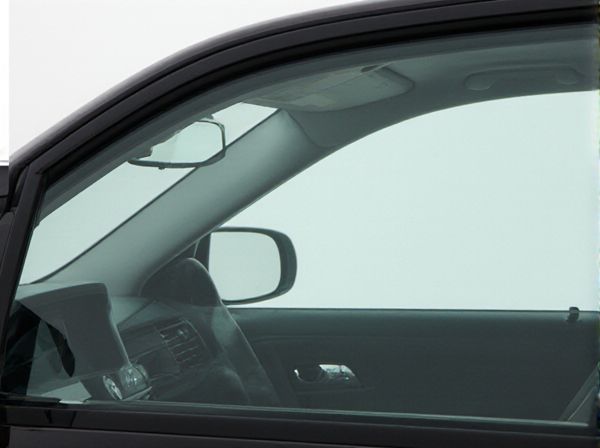
Photo illustration: UV-blocking Glass vs Standard Glass
UV-blocking glass significantly reduces harmful ultraviolet rays entering your space, protecting skin and preventing furniture fading. Standard glass offers minimal UV protection, allowing most UV radiation to pass through, which can damage interiors and increase health risks. Choosing UV-blocking glass enhances comfort, safety, and preserves the longevity of your belongings.
Table of Comparison
| Feature | UV-Blocking Glass | Standard Glass |
|---|---|---|
| UV Protection | Blocks up to 99% of UV rays | Blocks minimal UV rays |
| Heat Reduction | Significantly reduces heat buildup | Limited heat reduction |
| Glass Composition | Incorporates UV-absorbing layers | Basic glass composition |
| Driver & Passenger Safety | Prevents skin damage and fading of interiors | Increased risk of UV exposure |
| Cost | Higher initial investment | More affordable upfront |
| Durability | Enhanced with UV-block coatings | Standard durability |
Introduction to UV-Blocking Glass and Standard Glass
UV-blocking glass is engineered to filter out harmful ultraviolet rays, enhancing protection for interiors and reducing damage to furnishings, while standard glass allows most UV rays to pass through, offering minimal defense against sun-induced deterioration. This specialized glass incorporates coatings or interlayers that absorb or reflect UV radiation without compromising visibility or natural light transmission. Standard glass, typically composed of soda-lime silica, prioritizes transparency and structural integrity but lacks inherent UV filtration properties.
What is UV-Blocking Glass?
UV-blocking glass is specially engineered to filter out harmful ultraviolet rays, significantly reducing UV transmission compared to standard glass. This type of glass is coated or laminated with materials that absorb or reflect UV radiation, protecting interior furnishings and occupants from UV damage. Unlike standard glass, which typically blocks only a small fraction of UV rays, UV-blocking glass offers enhanced protection by filtering up to 99% of UVA and UVB radiation.
How Standard Glass Responds to UV Rays
Standard glass typically blocks most UV-B rays but allows a significant portion of UV-A rays to penetrate, which can contribute to skin damage and fading of interior furnishings over time. Unlike UV-blocking glass that contains special coatings or additives to filter out nearly 99% of harmful UV radiation, standard glass offers limited protection against long-wave UV-A rays. This incomplete filtration makes standard glass less effective in preventing UV-induced degradation in residential and automotive environments.
Key Differences Between UV-Blocking and Standard Glass
UV-blocking glass offers superior protection by filtering out up to 99% of harmful ultraviolet rays, reducing skin damage and fading of interior furnishings, whereas standard glass allows most UV rays to pass through. This specialized coating in UV-blocking glass enhances energy efficiency by minimizing heat transfer, unlike standard glass which provides minimal insulation. The durability and long-term cost savings of UV-blocking glass make it a preferred choice for automotive, residential, and commercial applications requiring enhanced UV protection.
Benefits of Using UV-Blocking Glass
UV-blocking glass significantly reduces harmful ultraviolet radiation, protecting interior furnishings from fading and deterioration. This advanced glass enhances occupant safety by minimizing skin exposure to UV rays, which are linked to skin cancer and premature aging. Energy efficiency is improved as UV-blocking glass reduces heat transfer, lowering cooling costs while maintaining clear visibility and natural light.
Limitations of Standard Glass
Standard glass typically blocks only a small portion of ultraviolet (UV) rays, allowing up to 75% of UVA radiation to pass through, which can contribute to skin aging and material fading. It lacks specialized coatings or treatments that enhance UV protection, making it ineffective against harmful long-term UV exposure. This limitation results in increased risks for interior damage and health concerns compared to UV-blocking glass designed to filter out up to 99% of UV radiation.
Applications and Common Uses for UV-Blocking Glass
UV-blocking glass is widely used in automotive windows, display cases, museums, and residential windows to protect occupants and valuables from harmful ultraviolet radiation. It is essential in preserving artwork, furniture, and archival documents by preventing UV-induced fading and deterioration. Unlike standard glass, UV-blocking glass significantly reduces UV transmission while maintaining visible light clarity, making it ideal for environments requiring both protection and visibility.
Cost Comparison: UV-Blocking vs Standard Glass
UV-blocking glass typically costs 20-30% more than standard glass due to its special coatings and materials designed to filter harmful ultraviolet rays. While the initial investment is higher, UV-blocking glass can reduce long-term costs associated with fading furniture, carpets, and interior damage caused by UV exposure. Standard glass lacks these protective properties but remains a more budget-friendly option upfront, making it suitable for projects with tighter cost constraints.
Maintenance and Longevity Considerations
UV-blocking glass significantly reduces the degradation of interior furnishings by filtering out harmful ultraviolet rays, which extends the lifespan of both the glass itself and the materials inside a protected space. Maintenance requirements remain similar to standard glass, typically involving regular cleaning to prevent buildup of dirt and grime, but UV-blocking coatings may require gentle cleaning agents to preserve their protective properties. The investment in UV-blocking glass contributes to longer-lasting window clarity and structural integrity compared to standard glass, which can yellow or weaken over time due to UV exposure.
Choosing the Right Glass for Your Needs
UV-blocking glass filters up to 99% of harmful ultraviolet rays, protecting interiors from fading and skin damage while enhancing energy efficiency. Standard glass allows more UV transmission, which may be suitable for applications where cost is a priority but offers limited protection against sun damage. Selecting the right glass depends on factors such as exposure to sunlight, desired durability, budget, and specific use cases like residential windows, automotive glass, or storefronts.
 caratoz.com
caratoz.com